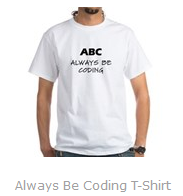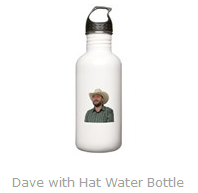Mentoring 101
 |
Mentoring 101 Review: This is a short book written by John C. Maxwell The author tries to make the point that training can help people and individuals. I think this part of the book from page 100 gives an example of that:
The author also goes into developing the right mindset to help others learn. From page 76:
It's a short book and was pretty cheap. The format and size of the book makes it feel like a Little Golden Book for adults. |
Read More
Radical Candor: Be a Kick-Ass Boss Without Losing Your Humanity
 |
Radical Candor: Be a Kick-Ass Boss Without Losing Your Humanity Review: A friend recommended I should read this. This was a slow read, there was a lot of information to absorb. The main message of this book is that clear and candid communication allows for better resolutions! Overall it was really good. It comes with two awesome tools the Get Stuff Done Wheel and the Radical Candor matrix. |
Read More
Outstanding!: 47 Ways to Make Your Organization Exceptional
 |
Outstanding!: 47 Ways to Make Your Organization Exceptional Review: This book was written by John G. Miller who is the author of QBQ - The Question Behind the Question. This book is composed of forty seven short chapters that vary in length between 3 to 10 pages about how to make your organization exceptional. It is a quick read. HOW NOT TO READ THIS BOOK: Read it from front to back, then put it down. HOW TO READ THIS BOOK: Read it from front to back, then put it somewhere and flip thru it sometimes. If there was a business improvement coffee table book this would be it. Each chapter is small and can be read in about 10 minutes. If you ever get bored instead of picking up the coffee table book of "Point Reyes Pictures" or "Steam Trains" pick this up and flip thru it and start reading. OVERALL: This is a pretty good book. Even if you don't read it all, read parts of it. Maybe even read random parts of it. The chapters are pretty self standing and don't reference each other. |
Read More
Pomodoro Technique Illustrated: The Easy Way to Do More in Less Time (Pragmatic Life)
 |
Pomodoro Technique Illustrated: The Easy Way to Do More in Less Time (Pragmatic Life) Everything that is in the book can be googled. Google "Pomodoro Technique". Pomodoro means tomato in Italian. The author (originator of the idea) found that breaking work up into predefined time periods and having a timer (a kitchen timer shaped like a tomato) and taking regular breaks increased their productivity. Does the technique work? YES. I use 20 minute timers for most tasks. I get interrupted alot by phone calls, emails and instant messages. By setting a timer to focus on things that need to be done I can push those emails and calls back by twenty minutes and deal with them afterwards. (Does an email need to responded to right away or can it wait twenty minutes? It can wait.) Should you buy this book? The whole idea is setting a goal you can complete in a short time frame (20 minutes) doing it (have a timer that goes off and stop working), then taking a five minute break. If you aren't done start another timer and continue. That is it. I believe you can learn more by googling "Pomodoro Technique" than reading this book. The book does have an interesting section about how our brains work, but in the context of the title it feels like filler. This is the timer I use. The timer comes in handy for limiting times on calls. I am bad about going over on call times. And TIME KILLS CALLS. Having a timer helps a lot. It is easy to lose track of time and having a simple timer seriously helps me focus on what I am trying to do and execute my tasks in a timely fashion. |
Read More
How to Lead When You're Not in Charge: Leveraging Influence When You Lack Authority
 |
How to Lead When You're Not in Charge: Leveraging Influence When You Lack Authority |
Read More
The Art of Unit Testing: with examples in C #
 |
The Art of Unit Testing: with examples in C Review: This is not a bad book. If you knew nothing about writing automated tests, this book would OPEN your eyes. You will learn about fakes and mocks. It doesn't go into the Moq framework very much. :( That said this book has problems. |
Read More
The Greatest Salesman in the World
 |
The Greatest Salesman in the World Review: This is an old book, but an EXCELLENT book. It was first published in 1968, and written by O.G. Mandino. The first half of the book is a parable about a manager working for his boss. His boss decides to retire and passes on his knowledge to his younger manager. This knowledge is contained in the form of ancient scrolls in a chest. The second half contains the content of the ancient scrolls. The entire books is very Assassin's Creed like. Instead of a secret clan of Assassins there is a secret group of expert sales people. This book is a quick read at around 100 pages, the reading flows and is entertaining. The real content starts around the scrolls. The first scroll explains how to read the later scrolls. I try hard to stay positive and persist at things. When I find myself in trouble or being super negative I read these scrolls and it helps a lot. |
Read More
Clean Architecture: A Craftsman's Guide to Software Structure and Design (Robert C. Martin Series)
 |
Clean Architecture: A Craftsman's Guide to Software Structure and Design (Robert C. Martin Series) |
Read More
The Clean Coder: A Code of Conduct for Professional Programmers
 |
The Clean Coder: A Code of Conduct for Professional Programmers |
Read More
Spy Secrets That Can Save Your Life: A Former CIA Officer Reveals Safety and Survival Techniques to Keep You and Your Family Protected
 |
Spy Secrets That Can Save Your Life: A Former CIA Officer Reveals Safety and Survival Techniques to Keep You and Your Family Protected |
Read More
The Five Dysfunctions of a Team: A Leadership Fable
 |
The Five Dysfunctions of a Team: A Leadership Fable |
Read More
People Buy You: The Real Secret to what Matters Most in Business
 |
People Buy You: The Real Secret to what Matters Most in Business |
Read More
QBQ! The Question Behind the Question: Practicing Personal Accountability at Work and in Life
 |
QBQ! The Question Behind the Question: Practicing Personal Accountability at Work and in Life |
Read More
Beyond Measure: The Big Impact of Small Changes (TED Books)
 |
Beyond Measure: The Big Impact of Small Changes (TED Books) |
Read More
Sell or Be Sold: How to Get Your Way in Business and in Life
 |
Sell or Be Sold: How to Get Your Way in Business and in Life |
Read More
If You're Not First, You're Last: Sales Strategies to Dominate Your Market and Beat Your Competition
 |
If You're Not First, You're Last: Sales Strategies to Dominate Your Market and Beat Your Competition |
Read More
32 Sales Objections Easily Countered: A Quick and Easy Guide to Countering the Most Common Sales Objections, Stalls, and Pushbacks with Words that Work
 |
32 Sales Objections Easily Countered: A Quick and Easy Guide to Countering the Most Common Sales Objections, Stalls, and Pushbacks with Words that Work
The non-fiction book "32 Sales Objections Easily Countered" by Stepp Stevens Sydnor One exercise the author suggests is asking people when you buy things "Is this the best price I can get?" DO THIS. The results are amazing and will show you how most people can't or don't counter objections |
Read More
The Art of Witty Banter: Be Clever, Be Quick, Be Interesting - Create Captivating Conversation
 |
The Art of Witty Banter: Be Clever, Be Quick, Be Interesting - Create Captivatin The non-fiction book the "The Art of Witty Banter" by Patrick King is a book that aims to teach you how to have interesting conversations. The book was short and easy to read. The subject is pretty approachable by anyone who has had a conversation, which should be most people on the planet. I didn't think I got a lot out of reading this book. However these are the things I liked and did not like. |
Read More
The 10X Rule: The Only Difference Between Success and Failure
 |
The 10X Rule: The Only Difference Between Success and Failure |
Read More
The 3G Way: An introduction to the management style of the trio who's taken over some of the most important icons of American capitalism.
 |
The 3G Way: An introduction to the management style of the trio who's taken over some of the most important icons of American capitalism. |
Read More
Exactly What to Say: The Magic Words for Influence and Impact
 |
Exactly What to Say: The Magic Words for Influence and Impact This is a short easy to read book written by Phil M Jones First, you aren't going to learn "magic words" that will let you manipulate people. The words the author goes over will help you work with most of the people, most of the time. The words will not work on all the people all the time. Second, this book isn't about words you can use to take advantage of people. The words will help you to help others make a decision. The book is formatted in short chapters of 2-3 pages with a word or phrase, a brief explanation of why it's a good idea to use it, and finally followed up with an example. The words may seem simple and obvious, but simple and obvious works! The easiest way to describe this is via an example word. Have you ever been scared to follow up with someone, because you knew they hadn't done what you wanted them to? Start the conversation off with: I'm guessing you haven't got around to... < insert some excuse > Let's say you were making a call where the other party had to talk to their spouse before making a decision, you would say: I'm guessing you haven't got around to talking to your spouse. The other person will be proud they did what they agreed to do "I did talk to them!" or they will make a new promise to speak with them. What this does is cut them off from making excuses. You have addressed that at the start of the conversation. It also lets the other person save face, because they don't have to make excuses to you why they didn't do something, they either did it or they can offer how they are going to correct the situation. The subsequent conversation you have with the other person will be more direct and more successful. |
Read More
The Only Sales Guide You'll Ever Need
 |
The Only Sales Guide You'll Ever Need I doubt that this is the "Only Sales Guide You'll Ever Need". The book is basically a complilation of themes and messages from other books. The book does have footnotes and references other books. The book by itself is not that great. However with the list of references and the ability to skim the subjects from the references in the book, it's easy to find other books that might interest or help you. This is a great book to read if you are looking for information from other sales books. Most of the other books referenced are very good. There are a lot of sales books in the market, this book best serves as a reference of which books are decent. Should you buy this? If you are new to sales or interested in learning, this is not a bad book. Treat it more like a reference to other books and decide which ones you want to read. That is where the true value is in this book. It's like a map that can lead you to read great sales books! |
Read More
Go for No! Yes is the Destination, No is How You Get There
 |
Go for No! Yes is the Destination, No is How You Get There
This is a very short, easy and fun to read book by Richard Fenton and Andrea Waltz The premise of the book is that you improve through failure. It also makes it a point to remind the reader that looking to fail can be a successful approach. A good example of this is how most people see "FAILURE - YOU - SUCCESS" being like a needle where you want to avoid failure and keep the needle in the success portion. The authors state that this is a better approach "YOU - FAILURE - SUCCESS", success can only happen through failures. I believe this is true. I learn more from my failures than through my successes. |
Read More






